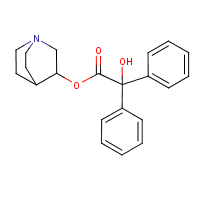Quinuclidinyl benzilate
Agent Name
Quinuclidinyl benzilate
CAS Number
6581-06-2
Formula
C21-H23-N-O3
Major Category
Toxic Gases & Vapors

Synonyms
3-(2,2-Diphenyl-2-hydroxyethanoyloxy)-quinuclidine; 3-Chinuclidylbenzilate;
3-Quinuclidinol benzilate; 3-Quinuclidinyl benzilate; 3-Quinuclidyl benzilate; BZ;
QNB; Ro 2-3308; [ChemIDplus]
Category
Chemical Weapons
Description
Crystals; [Sax] Odorless and nonirritating; [USAMRICD, p. 141]
Sources/Uses
"A High-affinity muscarinic antagonist commonly used as a tool in animal and tissue studies." [ChemIDplus]
Comments
BZ was developed as a chemical weapon in the 1960s. The same or similar compound (Agent 15) was detected in Iraqi stockpiles in 1998. BZ poisoning is manifested as the anticholinergic toxidrome, similar to poisoning by Jimson weed and many anticholinergic drugs (atropine, oxybutynin, scopolamine, antihistamines, etc.). BZ is an odorless and nonirritating solid that is soluble in propylene glycol and DMSO. Inhalation of aerosol is the most likely route of exposure, but it is also toxic after ingestion or skin absorption. Adverse effects are peripheral (red as a beet, dry as a bone, hot as a hare, blind as a bat) and central (mad as a hatter). Victims may have hallucinations, mumbling speech, and peculiar "woolgathering" movements of the hands. The two greatest risks to patients are 1.) injuries secondary to the intoxicated state and erratic behavior; and 2.) hyperthermia. [USAMRICD, p. 136-160]
Biomedical References
Exposure Assessment
Explanatory Notes
mp = 164-5 deg C; [Sax]
Adverse Effects
Neurotoxin
Other CNS neurotoxin
Diseases, Processes, and Activities Linked to This Agent
Other Information
No other related information on this agent was found.